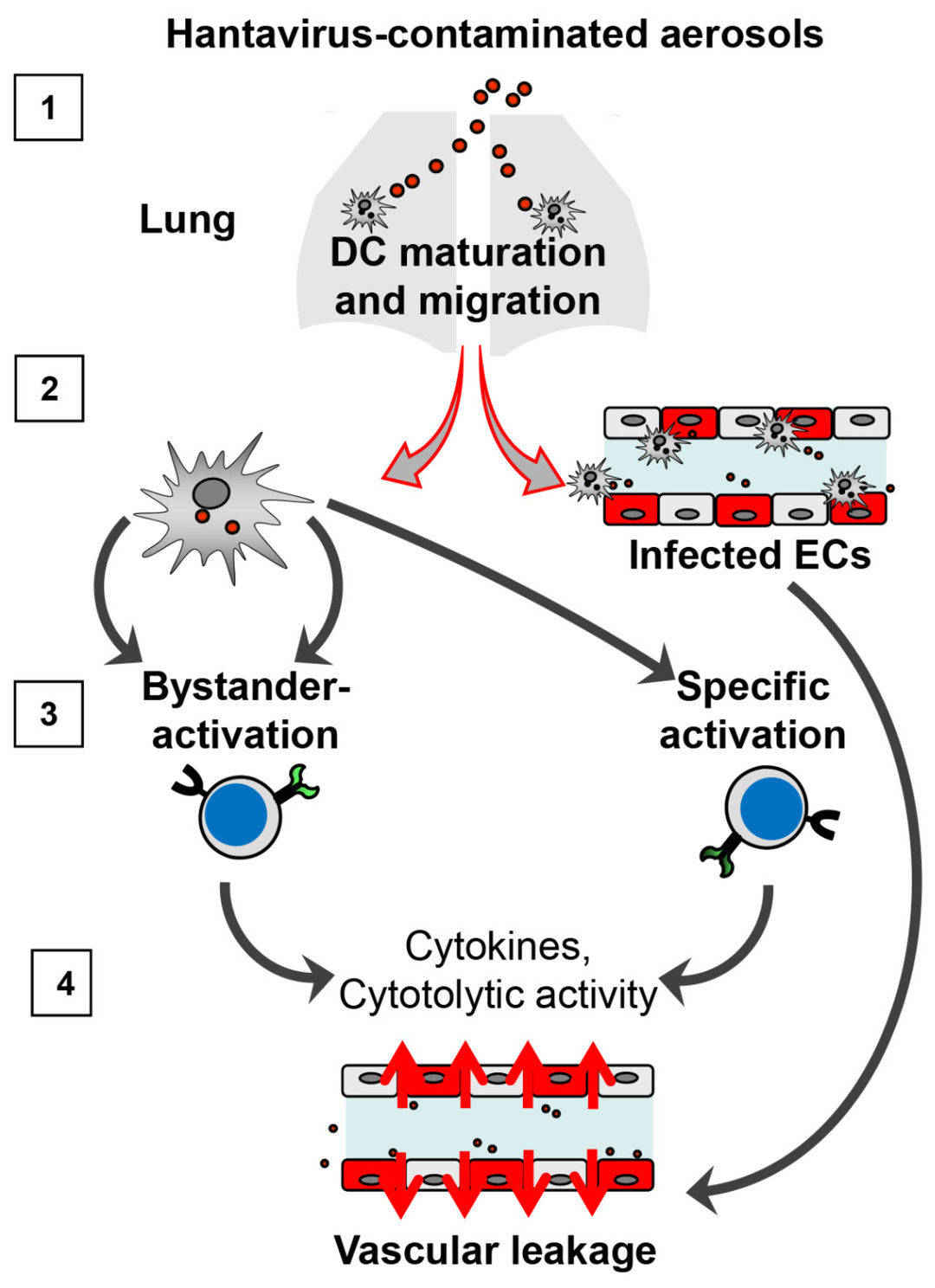Hantavirus pulmonary syndrome (HPS) is a severe and often fatal respiratory disease caused by New World hantaviruses, requiring rapid and accurate diagnosis for effective clinical management. This resource provides a comprehensive overview of current and emerging diagnostic approaches, including serological testing (IgM/IgG ELISA), molecular methods (RT-PCR), and novel biomarkers, along with their clinical applications and limitations.
Overview of Hantavirus Pulmonary Syndrome (HPS)
Hantavirus pulmonary syndrome (HPS) is a severe, often fatal respiratory disease caused by New World hantaviruses, primarily transmitted to humans through exposure to infected rodent excreta. Characterized by rapid onset of flu-like symptoms (fever, myalgia) progressing to acute cardiopulmonary failure, HPS has a mortality rate of up to 38%. Early diagnosis is challenging due to non-specific initial symptoms, necessitating a combination of serological (IgM/IgG ELISA), molecular (RT-PCR), and emerging biomarker-based approaches. Endemic to the Americas, HPS demands high clinical suspicion in at-risk populations and underscores the critical role of optimized diagnostic workflows to improve outcomes.
 Fig.1 Dendritic cells (DCs) as "fire accelerants" in hantavirus-induced pathogenesis. (Schönrich G, Raftery M J. 2019)
Fig.1 Dendritic cells (DCs) as "fire accelerants" in hantavirus-induced pathogenesis. (Schönrich G, Raftery M J. 2019)
Serological Testing for Hantavirus Pulmonary Syndrome (HPS)
Serological testing (gold standard) serves as the cornerstone of hantavirus pulmonary syndrome (HPS) diagnosis, detecting virus-specific antibodies produced during infection. These tests are particularly valuable after the first week of illness when antibodies become detectable, offering high sensitivity and specificity. Two critical components of serological testing include IgM/IgG ELISA for initial screening and confirmatory tests to ensure accurate diagnosis.
IgM/IgG ELISA
The IgM/IgG enzyme-linked immunosorbent assay (ELISA) is the primary screening tool for HPS, typically becoming positive 5-7 days after symptom onset. IgM antibodies indicate acute infection, while IgG antibodies suggest recent or past exposure. Commercial ELISA kits provide reliable results with sensitivities exceeding 90%, making them indispensable for early and accurate diagnosis in clinical and public health settings.
Confirmatory Tests
Due to potential cross-reactivity among hantavirus strains, confirmatory testing is often necessary. Techniques like immunoblot (Western blot) and plaque reduction neutralization test (PRNT) offer higher specificity, distinguishing between different hantavirus species and reducing false-positive results. These tests are particularly crucial in regions with multiple circulating hantavirus strains or for patients with atypical presentations.
Molecular Diagnosis of Hantavirus Pulmonary Syndrome (HPS)
Molecular techniques play a pivotal role in early hantavirus pulmonary syndrome (HPS) diagnosis by directly detecting viral RNA, enabling timely intervention before antibodies develop. These methods are especially critical in the acute phase (first 5–7 days of illness) and for immunocompromised patients with delayed seroconversion. Key approaches include RT-PCR for targeted detection, multiplex PCR for broad-spectrum screening, and digital PCR for enhanced sensitivity in low-viremia cases.
RT-PCR (Routine Testing)
Reverse transcription polymerase chain reaction (RT-PCR) is the gold standard for early HPS diagnosis, amplifying conserved regions of the hantavirus genome (e.g., S or M segments). It offers high specificity and a rapid turnaround (often <24 hours), but sensitivity depends on viral load and sample timing. Optimal specimens include whole blood, plasma, or tissues, collected before seroconversion.
Multiplex PCR
Multiplex PCR assays simultaneously target multiple hantavirus strains or co-pathogens (e.g., other rodent-borne viruses), streamlining differential diagnosis in endemic regions. This approach reduces resource use and is valuable for outbreak investigations, though design challenges include primer compatibility and maintaining sensitivity across targets.
Digital PCR (dPCR)
Digital PCR provides absolute quantification of viral RNA without standard curves, offering superior sensitivity for low viral loads (e.g., early infection or mild cases). While not yet widely adopted for routine HPS testing, dPCR shows promise for resolving equivocal RT-PCR results and monitoring treatment response in clinical trials. Its high cost and technical complexity currently limit use to reference labs.
Emerging Biomarkers for Hantavirus Pulmonary Syndrome (HPS) Diagnosis
Emerging biomarkers are revolutionizing early detection, prognostic assessment, and therapeutic response monitoring for hantavirus pulmonary syndrome (HPS). These novel markers target the host immune response, endothelial damage, and viral components, with the potential to improve diagnostic accuracy, especially during the critical early stages of infection.
HPS triggers a hyperinflammatory response characterized by elevated cytokines (e.g., TNF-α, IL-6, IFN-γ) and chemokines (e.g., IP-10, MCP-1), which correlate with disease severity. These markers help differentiate HPS from other febrile illnesses and may predict progression to severe cardiopulmonary failure, offering potential for early risk stratification.
- Endothelial Dysfunction Markers
Hantaviruses target endothelial cells, leading to vascular leakage. Key biomarkers like angiopoietin-2 (Ang-2) and sCD163 reflect endothelial activation and damage, providing insights into disease mechanisms and serving as prognostic tools for monitoring complications like capillary leak syndrome.
Direct detection of viral RNA (via RT-PCR/dPCR) or proteins (e.g., nucleocapsid antigen) enables early diagnosis before seroconversion. Emerging techniques focus on quantifying viral load in blood or urine, improving sensitivity for acute-phase detection and guiding therapeutic interventions.
Challenges and Future of Hantavirus Pulmonary Syndrome (HPS) Diagnosis
Despite advances in serological and molecular testing, HPS diagnosis faces significant hurdles, including the narrow diagnostic window for early detection (pre-seroconversion), geographic variability of viral strains leading to cross-reactivity, and limited access to specialized testing in resource-limited settings. Future improvements aim to integrate emerging biomarkers with point-of-care technologies, multiplex assays, and artificial intelligence-driven algorithms to enhance speed, accuracy, and accessibility.
Comprehensive IVD kits for hantavirus pulmonary syndrome (HPS) are provided by Alta DiagnoTech, featuring high-sensitivity ELISA and RT-PCR assays for accurate early detection and differential diagnosis. If you have related needs, please feel free to contact us for more information or product support.
Reference
- Schönrich G, Raftery M J. Dendritic cells (DCs) as "fire accelerants" of hantaviral pathogenesis[J]. Viruses, 2019, 11(9): 849.
This article is for research use only. Do not use in any diagnostic or therapeutic application.



 Fig.1 Dendritic cells (DCs) as "fire accelerants" in hantavirus-induced pathogenesis. (Schönrich G, Raftery M J. 2019)
Fig.1 Dendritic cells (DCs) as "fire accelerants" in hantavirus-induced pathogenesis. (Schönrich G, Raftery M J. 2019)



